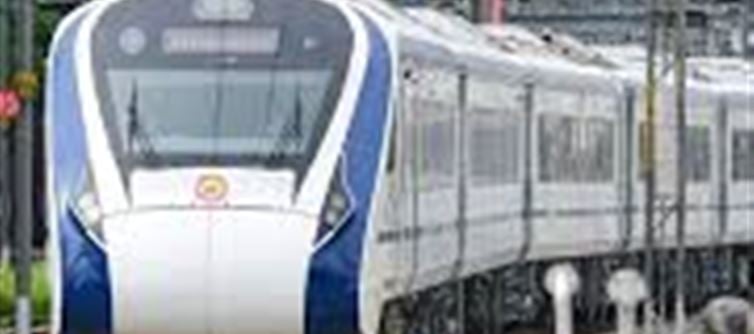
Indian Railways has always aimed to provide faster, more comfortable, and modern travel options for its passengers. Among these, the Vande Bharat Express has emerged as a game-changer. Known for its semi-high-speed services, advanced features, and shorter travel times, the train has revolutionized rail travel in India. With rising passenger demand, the Railways has now introduced special 20-coach Vande Bharat trains, significantly increasing seating capacity and convenience.
Here’s everything you need to know about the routes, stops, and benefits of these new 20-coach trains.
1. Why 20-Coach Vande Bharat?
Earlier, Vande Bharat trains operated with 16 coaches, which sometimes could not meet the growing passenger demand. By introducing 20-coach trains, indian Railways ensures:
- More seating capacity for passengers
- Enhanced comfort and amenities
- Improved connectivity across major cities
Currently, there are 13 pairs of 20-coach Vande Bharat trains running on various routes nationwide.
2. Key Features of 20-Coach Vande Bharat Trains
- Semi-high-speed: Faster travel reduces journey time significantly.
- Modern amenities: Comfortable seating, bio-toilets, infotainment screens, and automatic doors.
- Spacious coaches: Additional coaches mean less crowding, especially during peak travel seasons.
- Energy-efficient: Equipped with modern technology for better fuel efficiency.
3. Major Routes and Stops
Here’s a closer look at the 13 pairs of 20-coach Vande Bharat trains and their key stops:
Varanasi – New delhi – Varanasi: Varanasi, Prayagraj, Kanpur, New Delhi
New delhi – Katra – New Delhi: New delhi, Ambala, Ludhiana, Jammu Tawi, Katra
Mumbai Central – Gandhinagar capital – mumbai Central: mumbai Central, Borivali, Vapi, Surat, Vadodara, Ahmedabad, Gandhinagar
Visakhapatnam – secunderabad – Visakhapatnam: Visakhapatnam, Rajahmundry, Vijayawada, Khammam, Warangal, Secunderabad
Ajmer – chandigarh – Ajmer: Ajmer, Jaipur, Alwar, Gurugram, delhi Cantt, Chandigarh
Thiruvananthapuram – Kasaragod – Thiruvananthapuram: Kasaragod, Kannur, Kozhikode, Shoranur, Thrissur, ernakulam Town, Kottayam, Kollam, Thiruvananthapuram
Howrah – puri – Howrah: Howrah, Kharagpur, Balasore, Bhadrak, Jajpur Keonjhar Road, Cuttack, Bhubaneswar, Khurda Road, Puri
Howrah – patna – Howrah: Howrah, Durgapur, Asansol, Jamtara, Jasidih, Lakhisarai, Mokama, patna Sahib, Patna
Varanasi – New delhi – Varanasi: Banaras, Prayagraj, Kanpur, New Delhi
New delhi – Katra – New Delhi: New delhi, Ambala, Ludhiana, Jammu Tawi, Katra
Ayodhya Cantt – anand vihar Terminal – ayodhya Cantt: ayodhya, Lucknow, Kanpur, anand Vihar
Secunderabad – Visakhapatnam – Secunderabad: secunderabad, Warangal, Khammam, Vijayawada, Samalkot, Visakhapatnam
Chennai Egmore – Nagercoil – chennai Egmore: chennai Egmore, Tambaram, Villupuram, Tiruchirappalli, Madurai, Nagercoil
4. Benefits to Passengers
- Higher availability: More seats mean easier booking, especially during festivals and holidays.
- Faster travel: Reduced journey times between major cities.
- Comfortable ride: Modern coaches with better seating and amenities.
- Increased connectivity: Passengers can now travel more efficiently across metro cities and regional hubs.
5. The Future of Vande Bharat
The introduction of 20-coach Vande Bharat trains marks a significant step in indian Railways’ modernization drive. With increased capacity and premium features, these trains aim to redefine travel experiences for millions of passengers, making journeys faster, smoother, and more enjoyable.
Passengers across india can now enjoy the comfort of Vande Bharat while traveling longer distances, making it a true symbol of modern, semi-high-speed rail travel.
Disclaimer:
The views and opinions expressed in this article are those of the author and do not necessarily reflect the official policy or position of any agency, organization, employer, or company. All information provided is for general informational purposes only. While every effort has been made to ensure accuracy, we make no representations or warranties of any kind, express or implied, about the completeness, reliability, or suitability of the information contained herein. Readers are advised to verify facts and seek professional advice where necessary. Any reliance placed on such information is strictly at the reader’s own risk..jpg)




 click and follow Indiaherald WhatsApp channel
click and follow Indiaherald WhatsApp channel